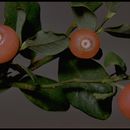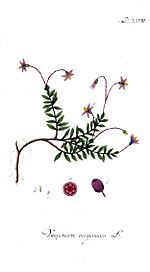en
names in breadcrumbs


Vaccinium /vækˈsɪniəm/[3] is a common and widespread genus of shrubs or dwarf shrubs in the heath family (Ericaceae). The fruits of many species are eaten by humans and some are of commercial importance, including the cranberry, blueberry, bilberry (whortleberry), lingonberry (cowberry), and huckleberry. Like many other ericaceous plants, they are generally restricted to acidic soils.
The plant structure varies between species: some trail along the ground, some are dwarf shrubs, and some are larger shrubs perhaps 1 to 2 m (3 to 7 ft) tall. Some tropical species are epiphytic.[4] Stems are usually woody. Flowers are epigynous with fused petals, and have long styles that protrude from their bell-shaped corollas. Stamens have anthers with extended tube-like structures called "awns" through which pollen falls when mature.[5] Inflorescences can be axillary or terminal. The fruit develops from an inferior ovary, and is a four- or five-parted berry; it is usually brightly coloured, often being red or bluish with purple juice. Roots are commonly mycorrhizal, which likely help the plants to access nutrients such as nitrogen and phosphorus in the acidic, nutrient-poor soils they inhabit.[4]
The genus was first described scientifically by Carl Linnaeus in 1753.[1] The name Vaccinium was used in classical Latin for a plant, possibly the bilberry or a hyacinth, and may be derived from the Latin bacca, berry, although its ultimate derivation is obscure.[6][7] It is not the same word as Vaccinum "of or pertaining to cows".[8]
The taxonomy of the genus is complex, and still under investigation. Genetic analyses indicates that the genus Vaccinium is not monophyletic.[9] A number of the Asian species are more closely related to Agapetes than to other Vaccinium species.[9][10] A second group includes most of Orthaea and Notopora, at least some of Gaylussacia (huckleberry), and a number of species from Vaccinium, such as Vaccinium crassifolium.[9] Other parts of Vaccinium form other groups, sometimes together with species of other genera.[9] The taxonomy of Vaccinium can either be resolved by enlarging the genus to include the entirety of the tribe Vaccinieae, or by breaking the genus up into several different genera.[9]

A classification predating molecular phylogeny divides Vaccinium into subgenera, and several sections:
The genus contains about 450 species,[17] which are found mostly in the cooler areas of the Northern Hemisphere, although there are tropical species from areas as widely separated as Madagascar and Hawaii. The genus is distributed worldwide except for Australia and Antarctica, but areas of great Vaccinium diversity include the montane regions of North and South America, as well as Southeast Asia.[4][18] Species are still being discovered in the Andes.[19]
Plants of this group typically require acidic soils, and as wild plants they live in habitats such as heath, bog and acidic woodland (for example, blueberries under oaks or pines). Blueberry plants are commonly found in oak-heath forests in eastern North America.[20][21] Vaccinium is found in both successional and stable sites, and is fire-adapted in many regions, withstanding low-intensity burns, and re-sprouting from rhizomes when above-ground tissues are burned off.[4]
Vaccinium species are used as food plants by the larvae of a number of Lepidoptera (butterfly and moth) species – see list of Lepidoptera that feed on Vaccinium. Berries of North American species nourish a variety of mammals and birds, notably including the grizzly bear.[4][22]
Two fossil seeds of †Vaccinium minutulum have been extracted from borehole samples of the Middle Miocene fresh water deposits in Nowy Sacz Basin, West Carpathians, Poland.[23]

Blueberries (sect. Cyanococcus) and cranberries (sect. Oxycoccus) are relatively newly cultivated plants, and are largely unchanged from their wild relatives. Genetic breeding of blueberries began around the turn of the 20th century, and was spearheaded by Frederick Coville who performed many cross-breeding trials and produced dozens of new blueberry cultivars.[24] He often tested new cultivars for their flavor, and claimed that after a long day of tasting, "all blueberries taste the same, and all taste sour."[24]
{{cite journal}}: CS1 maint: multiple names: authors list (link) Vaccinium /vækˈsɪniəm/ is a common and widespread genus of shrubs or dwarf shrubs in the heath family (Ericaceae). The fruits of many species are eaten by humans and some are of commercial importance, including the cranberry, blueberry, bilberry (whortleberry), lingonberry (cowberry), and huckleberry. Like many other ericaceous plants, they are generally restricted to acidic soils.